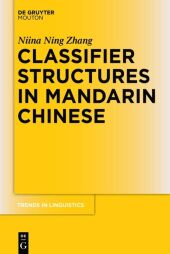 Neuerscheinungen 2016Stand: 2020-02-01 |
Schnellsuche
ISBN/Stichwort/Autor
|
Herderstraße 10
10625 Berlin
Tel.: 030 315 714 16
Fax 030 315 714 14
info@buchspektrum.de |

Niina Ning Zhang
Classifier Structures in Mandarin Chinese
2016. XII, 319 S. 230 mm
Verlag/Jahr: DE GRUYTER; DE GRUYTER MOUTON 2016
ISBN: 3-11-048805-1 (3110488051)
Neue ISBN: 978-3-11-048805-0 (9783110488050)
Preis und Lieferzeit: Bitte klicken
The series publishes state-of-the-art work on core areas of linguistics across theoretical frameworks as well as studies that provide new insights by building bridges to neighbouring fields such as neuroscience and cognitive science. The series considers itself a forum for cutting-edge research based on solid empirical data on language in its various manifestations, including sign languages. It regards linguistic variation in its synchronic and diachronic dimensions as well as in its social contexts as important sources of insight for a better understanding of the design of linguistic systems and the ecology and evolution of language.
This monograph addresses fundamental syntactic issues of classifier constructions, based on a thorough study of a typical classifier language, Mandarin Chinese. It shows that the contrast between count and mass is not binary. Instead, there are two independently attested features: Numerability, the ability of a noun to combine with a numeral directly, and Delimitability, the ability of a noun to be modified by a delimitive modifier, such as size, shape, or boundary modifier. Although all nouns in Chinese are non-count nouns, there is still a mass/non-mass contrast, with mass nouns selected by individuating classifiers and non-mass nouns selected by individual classifiers. Some languages have the counterparts of Chinese individuating classifiers only, some languages have the counterparts of Chinese individual classifiers only, and some other languages have no counterpart of either individual or individuating classifiers of Chinese. The book also reports that unit plurality can be expressed by reduplicative classifiers in the language. Moreover, for the constituency of a numeral expression, an individual, individuating, or kind classifier combines with the noun first and then the numeral is integrated; but a partitive or collective classifier, like a measure word, combines with the numeral first, before the noun is integrated into the whole nominal structure. Furthermore, the book identifies the syntactic positions of various uses of classifiers in the language. A classifier is at a functional head position that has a dependency with a numeral, or a position that has a dependency with a generic or existential quantifier, or a position that represents the singular-plural contrast, or a position that licenses a delimitive modifier when the classifier occurs in a compound.
Niina Ning Zhang, National Chung Cheng University, Taiwan.


